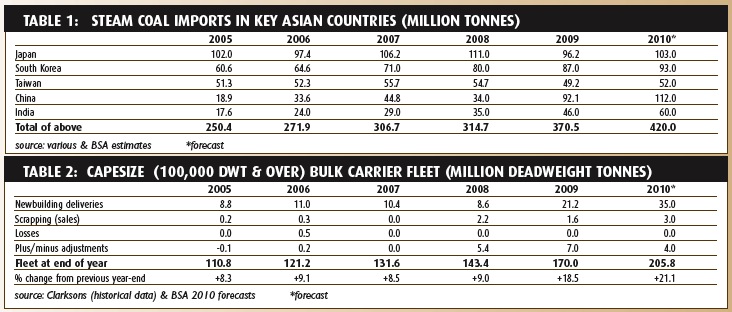by Richard Scott, Bulk Shipping Analysis.
Recent news and statistics confirm that, in a range of
dry bulk trades, activity is still buoyant and
prospects through 2011 seem positive. Signs of
additional import demand for commodities are clearly
visible. But evidence pointing to a temporary slowing of
economic growth in major dry bulk importing areas has
become more prominent, implying some negative effects on
trade volumes.
Amid huge problems faced by many countries in the
aftermath of the ‘Great Recession’, current difficulties are
hardly surprising. The Asian Development Bank recently
highlighted “the continued fragility and uncertainty of
recovery in the industrialized countries”, commenting that
the global recovery “remains shaky”. However, further
useful support from emerging markets’ dynamic progress is
expected.
COALStrong import demand for steam coal is one promising
aspect. As shown by table 1, countries in the Asian region
are buying more foreign supplies. Extra purchases by China
and India are especially notable. World seaborne steam coal
trade could rise by 7–8% in 2010, followed by further growth
next year.
India’s coal imports expansion is attracting much
attention. After growing strongly to reach about 85mt
(million tonnes) in 2009, another large increase, possibly
about 20%, could push overall steam and coking coal imports
up to around 100mt this year. Indian steam coal purchases,
now comprising over two-thirds of the total, are advancing
rapidly as coastal power stations increasingly use foreign
material to augment domestic supplies.
IRON ORERestraining influences affecting global iron ore trade have
become prominent. In the third quarter of this year, China’s
imports totalled 148mt, continuing a steady decline in
quarterly volumes since the peak 172mt was reached in last
year’s third quarter. An upturn during the 2010 final three
months is widely predicted, but the annual volume is likely
to be below last year’s total.
Blast furnace pig iron production figures for the
July–September 2010 quarter provide more evidence of
flattening iron ore consumption trends. In Japan, pig iron
output recovered strongly to 20.1mt in last year’s final
quarter, since when it has advanced only modestly to 20.8mt
in the latest period. European Union production averaged
24.4mt during the past three quarters, and South Korea has
averaged 7.7mt in the past four quarters.
GRAINGlobal import demand for grain remains subdued.
International Grains Council estimates suggest that world
trade in wheat, corn and other coarse grains will be almost
unchanged in crop year 2010/11 ending June, at 239.6mt.
Asian and Middle East imports are likely to decline, but in
North Africa, Europe and Russia, offsetting increases are
expected.
Imports of grain into Russia were almost nil in the
previous two crop years, but could rise to about 4mt in the
current twelve months. This summer’s harvest shortfall,
when production fell by one-third to 63mt, has resulted in
Russia’s role as a key exporter temporarily ceasing, and a
potential import demand for a substantial quantity to
augment tight domestic supplies.
MINOR BULKSAluminium production among key areas importing raw
materials — bauxite and alumina — is showing limited signs
of growth. In North America, output has been flat in the
past twelve months. West Europe’s quarterly output
increased steadily during that period and in third quarter
2010 was 6% higher than a year earlier. China’s quarterly
output over the same period rose by 4%.
The world fleet of Capesize ships is growing faster than other
bulk carrier size groups and probably will continue expanding
very rapidly next year as well. As shown in table 2, a
massive volume of newbuilding deliveries, accompanied by
more tanker conversions and low scrapping, is likely to result
in Capesize fleet deadweight capacity exceeding 20% growth
in 2010. The end-December total could reach about 206m
dwt.
